Windows on Steam Deck: Benchmarks and Impressions
Windows is a bit rough around the edges on Steam Deck.
One constant through Valve's introduction of the Steam Deck has been the company's claim that it is your PC, and you can do what you want with it. While the gaming handheld comes with Valve's own Linux-based SteamOS installed on it, you can, if you want, install Windows on the Steam Deck.
So we took our Steam Deck review unit, put Windows 10 on it, and gave it a whirl. While there are some definite advantages to the openness that Windows brings, there are also significant drawbacks that you should be aware of. And, in typical Tom's Hardware fashion, we've also re-run our benchmarks to see how gaming on Windows compares to SteamOS (on this hardware, anyway).
Here, we're using Windows 10, rather than Windows 11. As of this writing, the BIOS on the Steam Deck doesn't support firmware TPM, which makes it difficult to install Windows 11 without engaging in some bypasses. That support is coming in a future BIOS revision, Valve has said.
Additionally, while Valve has dropped drivers for the GPU, Wi-Fi and Bluetooth, one critical component is missing: the speakers. That means that until those drivers are released, the only way to hear your games, music or anything else will be to connect wireless headphones or speakers over Bluetooth, or wired ones with USB Type-C.
Steam Deck Performance on Windows
I assumed that given the same hardware, games run on Windows would almost always run better than games on SteamOS. That's because unless games are Linux native, SteamOS games use the Proton compatibility layer to operate.
But that wasn't always the case. Some games actually performed better on SteamOS.
In our Steam Deck review, we benchmarked Shadow of the Tomb Raider, Red Dead Redemption 2, Horizon Zero Dawn, Borderlands 3, Civilization VI and Guardians of the Galaxy. Of those, three ran largely better on Windows, while the other three ran better through SteamOS (in part because one game wouldn't run in Windows at all due to driver issues).
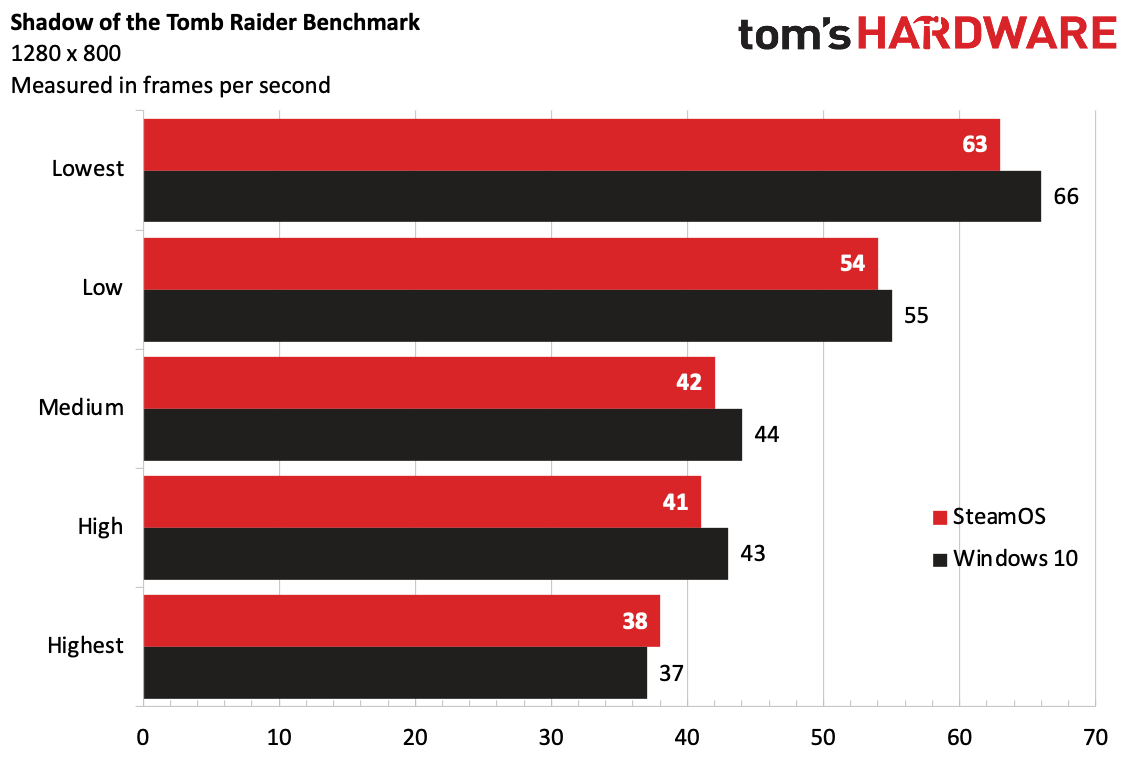
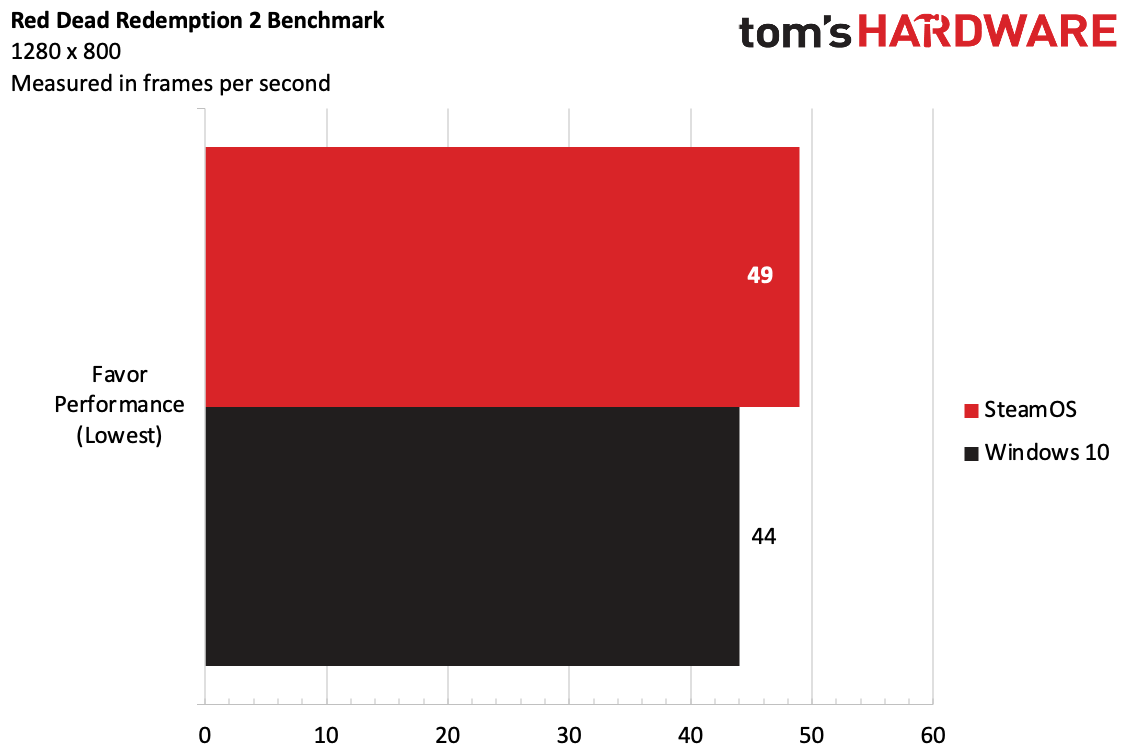
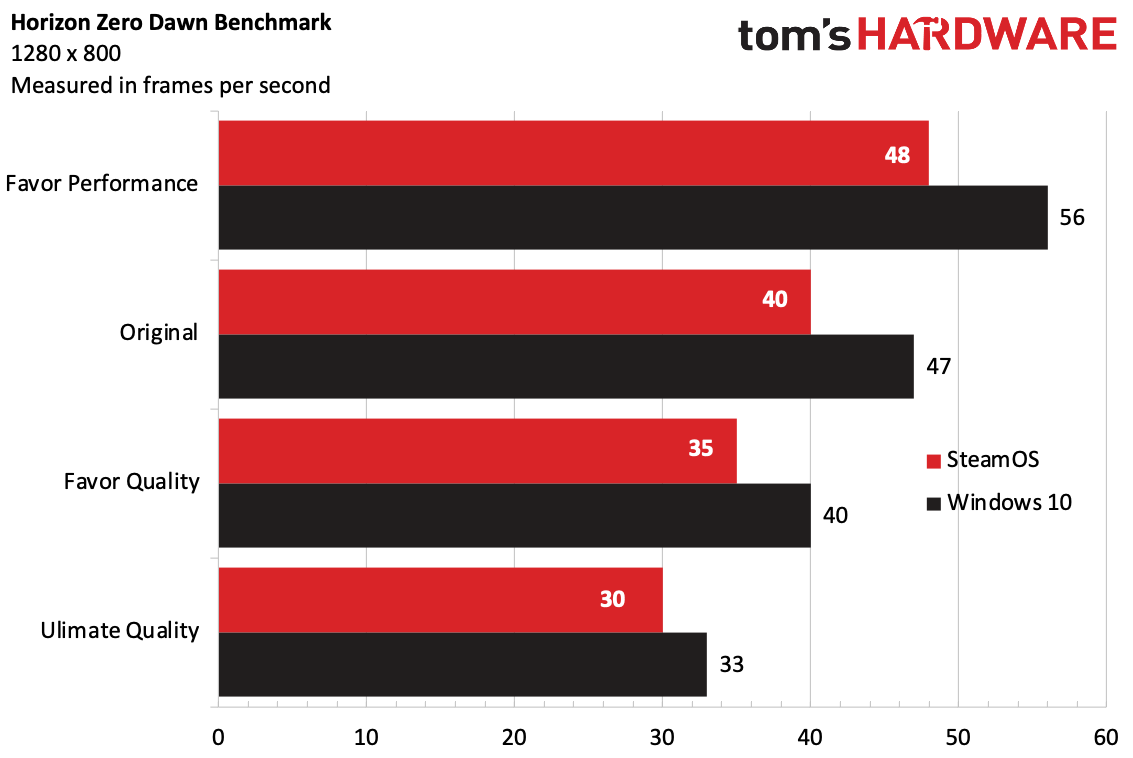
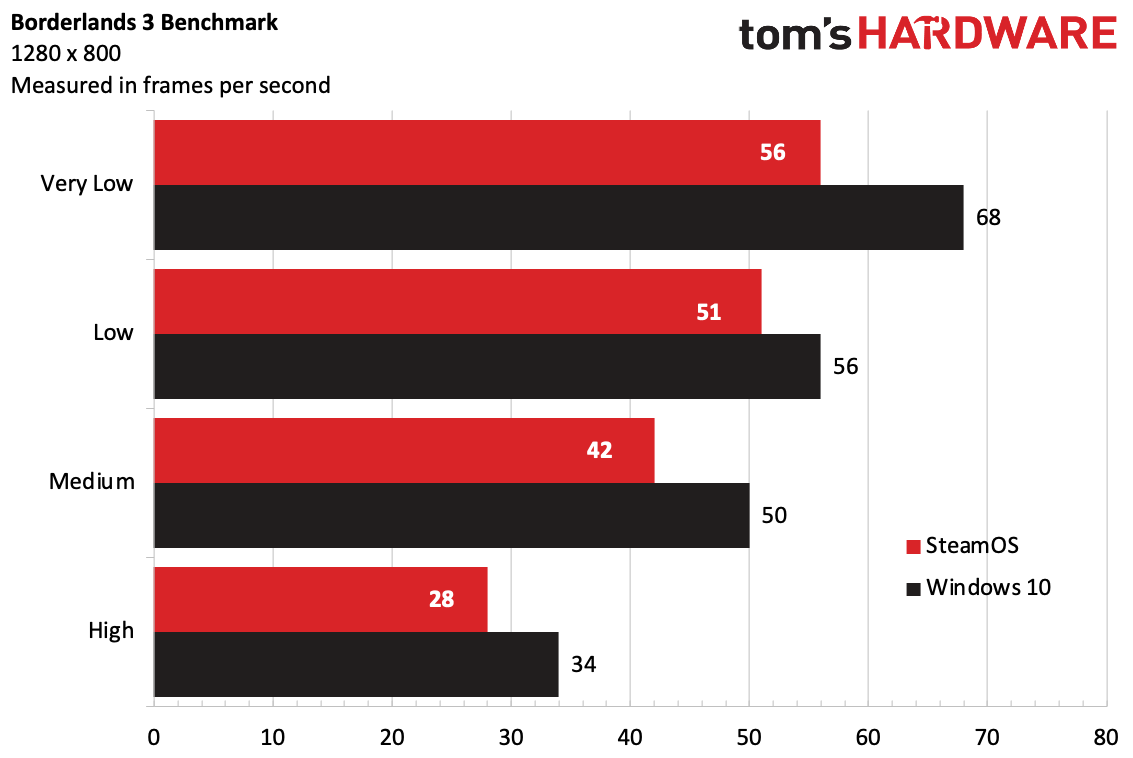
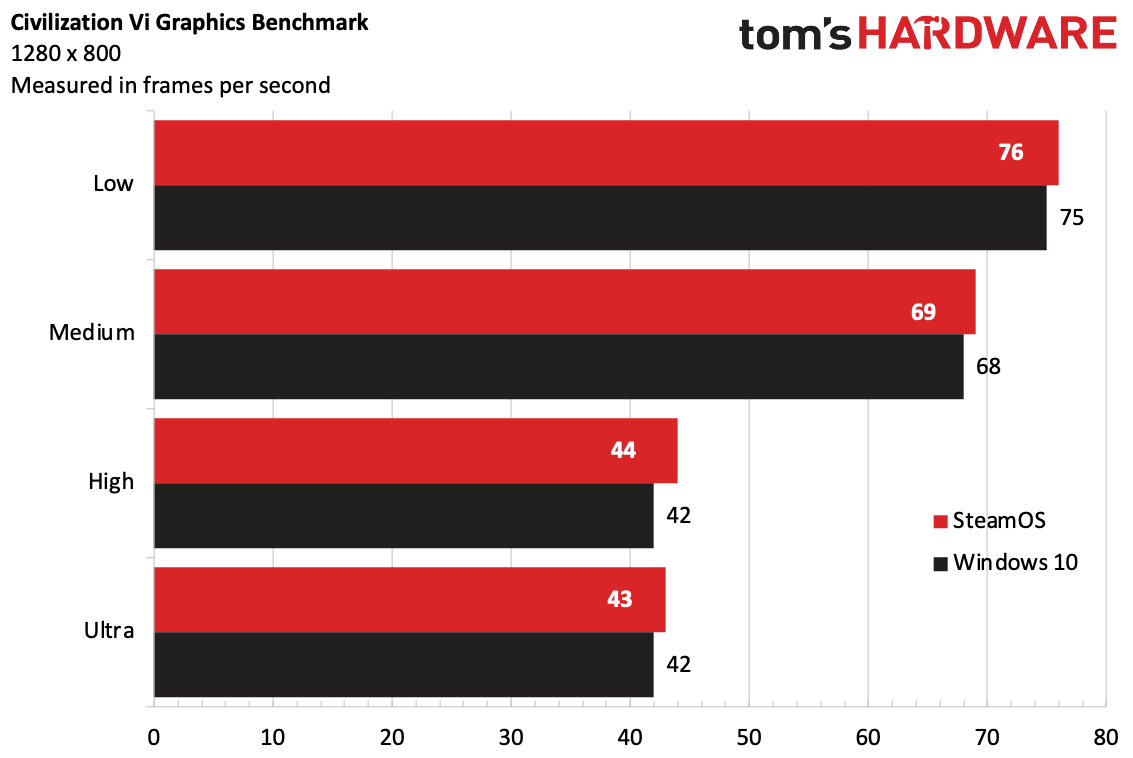
On the Shadow of the Tomb Raider benchmark, which is a Linux native game on the SteamOS side, the title mostly ran two to three frames ahead on Windows. The exception was the highest graphics setting, where the two versions were one frame apart, with SteamOS coming out ahead.
We ran Red Dead Redemption 2 at the game's lowest settings, and at 44 frames per second, the Windows version was a few frames behind the SteamOS version, running through Proton. The Windows version also had some other issues. For instance, it refused to let me change the resolution, but always appeared to run at 1280 x 800 despite what it claimed. The game also wouldn't launch without me connecting Bluetooth headphones. It ends up that Red Dead Redemption 2 won't launch without audio, and the Steam Deck is missing those drivers.
On the Horizon Zero Dawn benchmark, the game ran better on Windows across graphics presets. The delta was the largest on the "Favor Performance" setting, with Windows running the game at 56 fps, eight frames ahead of the 48-fps result on the Steam Deck. Those differences shrank in scale with higher presets (at Ultimate quality, it was just a three-frame difference), but Windows always came out ahead.
Borderlands 3's benchmark showed the largest differences in Windows 10's favor. At "very low" settings, the game ran at 68 fps on Windows compared to 56 fps on SteamOS, and was a few frames ahead through each subsequent preset. On high settings, the game ran at 34 fps, making it at least playable, which we couldn't say about the game at 28 fps through SteamOS.
Civilization VI was effectively a wash, but if you're counting strictly, it fell in favor of SteamOS. The game typically ran one to two frames ahead in SteamOS.
Where is Guardians of the Galaxy in all of this? It wouldn't run on Windows. The game threw up an error message that it couldn't detect a D3D12 driver, suggesting an issue with support for DirectX 12 (other games we ran with DX12 didn't have any problems.)
Get Tom's Hardware's best news and in-depth reviews, straight to your inbox.
When we tested the Steam Deck initially, we couldn't run Metro Exodus's benchmark, because it's a separate executable in the Windows version. But on Windows, that wasn't a problem. We booted up HWInfo and got recording. We use that benchmark as a stress test, running it 15 times to simulate half an hour of gaming. In this case, we ran it on the low preset at the native 1280 x 800 resolution.
HWInfo, however, still isn't totally ready for the custom "Aerith" APU in the Steam Deck. It was only able to capture CPU clock speeds. During the stress test, the CPU cores ran at an average of 2.62 GHz. Temperatures and GPU clocks weren't exposed. Throughout the 15 Metro Exodus runs, the game ran at an average frame rate of 64.61 fps.
In our review, we also ran Geekbench through the KDE Plasma desktop. Here, we ran it again in Windows 10. The Linux version threw up slightly higher single-core and multi-core scores than the Windows version, but nothing I find intensely worrying.
The Windows Experience on Steam Deck
While games may run well enough on a 7-inch 1280 x 800 display, desktop operating systems really need a bit more breathing room. I felt the same way about the KDE Plasma desktop on SteamOS; I was glad to have access to it, but I wouldn't want to use it regularly using just the built-in controls and screen.
One of the biggest benefits of SteamOS is that it was designed with both touch and the built-in controller in mind. Windows, despite changes made to make it more touch friendly, wasn't made for a screen this small.
You can get around Windows with the controls, but there's a learning curve. The right control stick or touch pad (Go for the pad, trust me) can move the mouse around. The left stick can move through selections in menus, while the right touchpad lets you scroll either vertically or horizontally.
One thing that took me a while to get used to is that the right trigger is a left click, while the left trigger is a right click. This might make sense if you're playing a first person shooter, where the right trigger is typically set to fire, but I found it confusing here.
Either way, I did find that sometimes the controls would freeze, especially when launching programs. It's weird to have your mouse hang, but sometimes the touchpads — including the haptics — would freeze up.
There is a touch keyboard in Windows 10, but there's also the option for the Steam keyboard overlay, which lets you use each of the two touchpads to pick letters. As long as Steam is open, you can trigger that by pressing on the thumb sticks.
In Windows 10, the Action Center will be your friend. You'll want to expand all of the options so that you have quick access to the brightness slider and Bluetooth connection options. I wish you could bind these to the "..." button on the hardware, which is otherwise useless in Windows 10. For now, if you're playing a game and want to adjust an option, you have to back out to the desktop to make these changes.
The "Steam" button also does nothing, with one big exception: Big Picture Mode in Steam. Like SteamOS itself, this was designed to be used with a controller. When in a game, the Steam button brings up the Big Picture mode overlay for controller options, the keyboard overlay and to exit the game easily.
Those controller options also let you bind a shortcut for screenshots while playing Steam games. But the Windows Screenshot tool is heavily dependent on the Windows + Shift + S shortcut which makes it a hassle to capture images if you don't know how. See our article on how to take screenshots in Windows 10 or 11 to learn all the ways you can (even without a keyboard).
Big Picture Mode is the closest you'll get to SteamOS. It also provides some of the controller configurations you get with SteamOS, giving Steam a bit of an edge over other stores, even on Windows.
But the biggest benefit to installing Windows on your Steam Deck is that you can install launchers other than Steam. Epic Games, Origin, GOG Galaxy, Rockstar Games and others are all fair game. If you have PC Game Pass, those games will work, too, as will games that don't run on SteamOS due to anti-cheat issues.
You could even install a library manager like Playnite to launch games from any launcher in one place. (But you have to trust them. Playnite, for instance, requires your logins for other launchers to sync everything.)
I imagine, in time, that the community of Steam Deck users may end up coming up with its own software and fixes to issues the Steam Deck has with Windows. It wouldn't be the first time that when no one supports something, the users do. But there's no timeframe on when Steam Deck users and developers may coalesce around fixing issues, but Valve has already said that it is"unfortunately unable to offer 'Windows on Deck' support."
SteamOS or Windows?
There's no doubt, the Steam Deck is a better experience when it's running SteamOS. It fits the hardware and has quick access to any setting you may want to change mid-game.
Windows, by contrast, doesn't have the same support, and Valve says it won't be providing it. It works, and some games even run better on it. But you'll have to jump through more hoops to make it work. You'll get the benefit of the freedom that the PC ecosystem provides, including more launchers and games that aren't on Steam.
The ideal, to me, would be dual booting. Valve has said it is working on a SteamOS installer that will allow for it, but the company hasn't announced any timing. Right now, it's an all-or-nothing situation with the SSD. SteamOS or Windows. Pick one.
Ideally, you could keep your Steam library on SteamOS with a small Windows partition for Epic Games, PC Game Pass or other launchers. Right now, the closest you can do is to install Windows on an SD card. We haven't run performance tests there, but going that route should let you easily swap between Windows and SteamOS by changing the boot device. You can learn how to do that in our tutorial if you want to try it out.
If your entire library is on Steam, there's no reason to switch. But the PC ecosystem has always been about openness, so while the Windows experience is rougher around the edges than I would like, I'm grateful that it works. I have plenty of free games I've downloaded from Epic and I ought to get to them eventually.

Andrew E. Freedman is a senior editor at Tom's Hardware focusing on laptops, desktops and gaming. He also keeps up with the latest news. A lover of all things gaming and tech, his previous work has shown up in Tom's Guide, Laptop Mag, Kotaku, PCMag and Complex, among others. Follow him on Threads @FreedmanAE and BlueSky @andrewfreedman.net. You can send him tips on Signal: andrewfreedman.01
-
watzupken My response to, “Windows is a bit rough around the edges on Steam Deck”, is that Windows is rough on any system that it runs on. Just because desktop/ laptops have ample of processing power to hide the inefficiencies of the OS, thus, we don’t see it as a big problem.Reply -
Reply
agreed. I have to disable most all telemetry to get my mini pc to be quiet 99% of the time, else it's ALWAYS doing unasked for diagnostics/telemetry ( I have watched it extensively in Resource Manager, I hate them so much for this cursed os)watzupken said:My response to, “Windows is a bit rough around the edges on Steam Deck”, is that Windows is rough on any system that it runs on. Just because desktop/ laptops have ample of processing power to hide the inefficiencies of the OS, thus, we don’t see it as a big problem.
after I am done with it it mostly behaves. I don't ever want ANYTHING off the stupid store, nor any of their bloatware apps yet it keeps getting foisted on me.
my next pc is a System76 mini or laptop running their popOS! I will run Windows only as VM from there on out should the need arise.
I use this to debloat
GitHub - Sycnex/Windows10Debloater: Script to remove Windows 10 bloatware.
Steam should make a windows vm for windows gaming and use gpu passthru for performance, that way they can control what windows runs, so they can strip it of all unessential crapola and disable updates completely. basically make it like the Xbox OS, stripped to the bone for console use only.
They can even use Windows Embedded and set up the image as a gaming console so it has ALL the required hardware but can't be used as PC--because what's the point? It's a console for games. In that way they could custom tailor a gaming OS for the VM to run. -
ezst036 ReplyAdmin said:Windows, by contrast, doesn't have the same support, and Valve says it won't be providing it. It works, and some games even run better on it. But you'll have to jump through more hoops to make it work.
This is very strange to me. Like living in an alternate reality. Valve has, whether through just the simple/standard "we only support our stock factory settings" or a malicious anti-Microsoft viewpoint, put the shoe on the other foot.
This is not me gloating. I take no glee from this.
For years, Linux has garnered a bad reputation because "this thing" here does not work nor "that thing" over there does not work and Linux users have been forced into a corner by Microsoft and by vendors. "But but!" They don't provide support! The Linux user has been forced to say. It was never that it couldn't work, it was that the vendor didn't do the work that would help complete it's functionality.
This may be the first time a Windows user, on a significant platform, has been forced into the exact same place. This is why I take no glee from this. Yes, a Windows user can now say they "know what it feels like", but the problem or even moreso, the reality is that I wouldn't want to push a Windows user into that place I've fought so hard to get out of. I know how bad that place feels. I'm NOT wishing it on anybody.
I didn't fight to get out of that place, just to replace it with someone else. I fought to get out of that place to empty it. It should remain an empty place.
Valve says they won't be providing support, well, they should. This is not acceptable. -
NightHawkRMX I wonder if it would be possible to dual boot by first installing steamOS, and then installing Windows afterwards, since Windows does support dual booting and can partition drives for tht.Reply -
TerryLaze Reply
You drunk? It's gonna take years of high volume sales before the deck becomes significant.ezst036 said:This may be the first time a Windows user, on a significant platform
Also all the consoles up to now, if hacked, where able to run some sort of linux but not windows, also mac was all linux and had to be "hacked" for windows.
Linux handles dual boot just fine and there are also stand alone boot managers that can handle it.NightHawkRMX said:I wonder if it would be possible to dual boot by first installing steamOS, and then installing Windows afterwards, since Windows does support dual booting and can partition drives for tht.
The thing is there is no easy fool proof method of doing it, which is why nobody will offer support for something like that. -
waltc3 I don't think people who buy a Deck are actually looking for a desktop Windows experience--uh, mainly because the Steamdeck isn't a desktop--not even close, imo. From what I've read, Steam deck does support dual booting as it ships, but Valve is fairly lackluster on the drivers for Windows. I think ten years ago that 1280x800 might have been a common resolution. It's just another vehicle by which Valve can sell more games. A really niche market and the portability is what you pay for--as with laptops.Reply -
excalibur1814 If you want a nice little gaming machine, buy a Steam Deck and cross your fingers that it works with your game (even if Valve states that it will).Reply
If you love the form factor and want to do more than game, OneXplayer or Aya Neo. Connect to a monitor or TV, done.
If you want something with a larger screen, A Surface Pro 8 with an xbox controller isn't bad at all.
There's a place for everything. However, Valve really should improve their drivers for this 'thing'. Additionally, reviewers and web pages such as this should leave the comments until it's finished. Clicks and views with ad-revenue is one thing, but the device isn't 'ready' for windows.
P.s. Don't like Windows? Then make the move already and stop bleating. You can always switch stuff off with Windows. Good luck with the un-finished Steam Deck in either OS guise. -
excalibur1814 Replywaltc3 said:I don't think people who buy a Deck are actually looking for a desktop Windows experience--uh, mainly because the Steamdeck isn't a desktop--not even close, imo.
If you install Windows and use a keyboard and mouse with a monitor, it'll have a desktop windows experience. Same for the OneXPlayer. Why limit your view? -
Kockm This article is great but the writer is confidently incorrect about needing to have Windows for an “open” platform and stating that as a downside to the Steam Deck. Linux is literally the most open operating system that exists and Valve is not preventing you from installing other game stores or software on SteamOS. You can play all your Epic Game Store games and install other storefronts through Proton / wine. Check out Lutris, which is a launcher that has one click install scripts for thousands of games, or Heroic Launcher, which is an open source Epic Games Store launcher. Just because you aren’t familiar with SteamOS or Linux doesn’t mean it’s limiting the user.Reply


